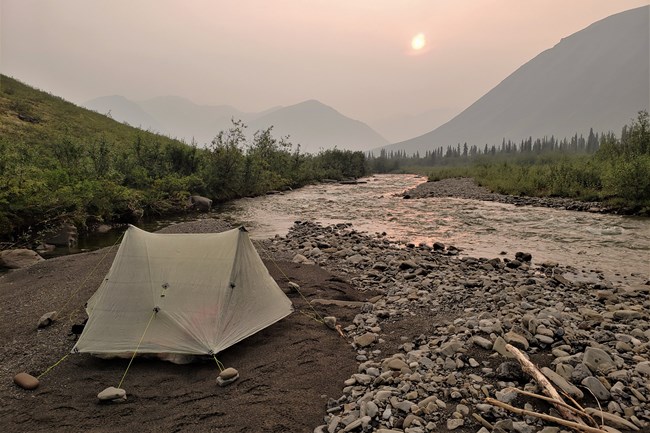|
To report a wildland fire in Alaska, call 911 or the Alaska Interagency Coordination Center at 1-800-237-3633. Despite the long, severe winters and relatively short summers in Gates of the Arctic, wildland fires do occur and are a natural part of the ecosystem. While tundra fires occur infrequently in the northernmost two-thirds of the park due to the Brooks Range and Arctic coastal influences on the North Slope, as seen in the lack of vegetation to burn in the rocky or sparsely vegetated alpine tundra of the Brooks Range and the increased precipitation, both boreal forest and tundra are subject to fires. The most frequent and largest fires occur in the park's forested areas, the southern third of the park, lying within Alaska's northernmost interior lightning belt where fire is a significant, natural process. This area is located mainly in the Kobuk Preserve, where plant communities include fire-prone black and white spruce. As a fire burns across a landscape - some areas are lightly burned and other areas may be severely burned. Burn severity impacts post-fire vegetation and which plant species come back after a fire. For thousands of years, select plants and animals have adapted to periodic large and small high-intensity fires. If burn severity is low or moderate, the above ground plants may be singed or burned, but much of the vegetation will be able to resprout quickly from roots and stems. However, severe fires burn deeper into the organic soils which may kill off the underground root structure of some shrubs and herbaceous plants. Therefore plant reproduction may be more dependent on seed establishment or deep rooted plants. Both black and white spruce depend on intense ground fire to clear organic layers and expose fertile seedbeds. At the peak of the Alaskan Interior fire season in June and July, black spruce seeds become ready for germination. Seeds are released when canopy fire opens the cones. Black spruce semi-serotinous cones are unique because they partially rely upon high-intensity fires in order to open. White spruce colonizes mineral soil seedbeds after intense ground fires and black spruce is partially dependent upon fire activity for reproduction. Aspen and birch trees can resprout after low severity fires, but may seed in after a high severity fire. Fire also plays a key role in the regulation of the permafrost table throughout this area. Without fire, organic matter accumulates, the permafrost table rises, and ecosystem productivity declines. Vegetation communities become less diverse and wildlife habitat decreases. Fire rejuvenates these systems. It removes insulating organic matter and elicits a warming of the soil. Combustion and increased decomposition rates return nutrients to the soil. What at first looks like devastation soon blooms into a panorama of life. Changes in vegetation due to fires, in turn, affect wildlife distribution and habitat use. Patchy fires create a mosaic of habitats frequently used by snowshoe hares and martens, while moose often browse on resprouting willow, aspen or birch after fires. Small mammals such as voles often thrive in recently burned areas, creating large colonies in the remaining duff and feeding on new vegetation. Caribou, on the other hand, may tend to avoid recently burned areas lacking sufficient lichen for winter forage. Ultimately these fire related changes to wildlife habitat and therefore animal distribution in the park affects subsistence users who rely on the availability of these animals. Because of the vast and remote location of Gates of the Arctic, very few fire suppression efforts occur in the park. NPS Fire Management protects human life, private property, and cultural and natural resources that warrant protection. Managers also allow fire to fulfill its role as a natural process to the fullest extent possible. Long term monitoring of fire effects like the number of fires, fire acreage, and affects to vegetation will help scientist and land managers understand ecological change and the relationship between fire and the landscape. Fire is a "Vital Sign" for the Arctic Network Inventory and Monitoring Program (ARCN). Information gathered from research and monitoring will be used to:

NPS/Yasunori Matsui 
NPS/Josh Spice Alaska and nationwide fire information:
Alaska Fire Service Interagency Coordination Center Alaska Division of Forestry, Fire Management Programs, and Current Fire Information National Park Service Fire and Aviation/Firenet National Interagency Fire Center FIREWISE is a multi-agency program that teaches individuals who they can lessen the risk of wildland fire to their home, property and community. Related Alaska Wildland Fire Content |
Last updated: November 15, 2022
